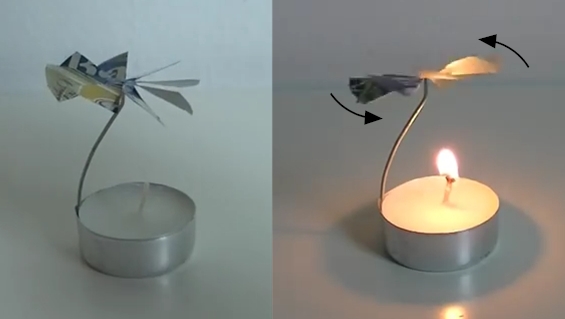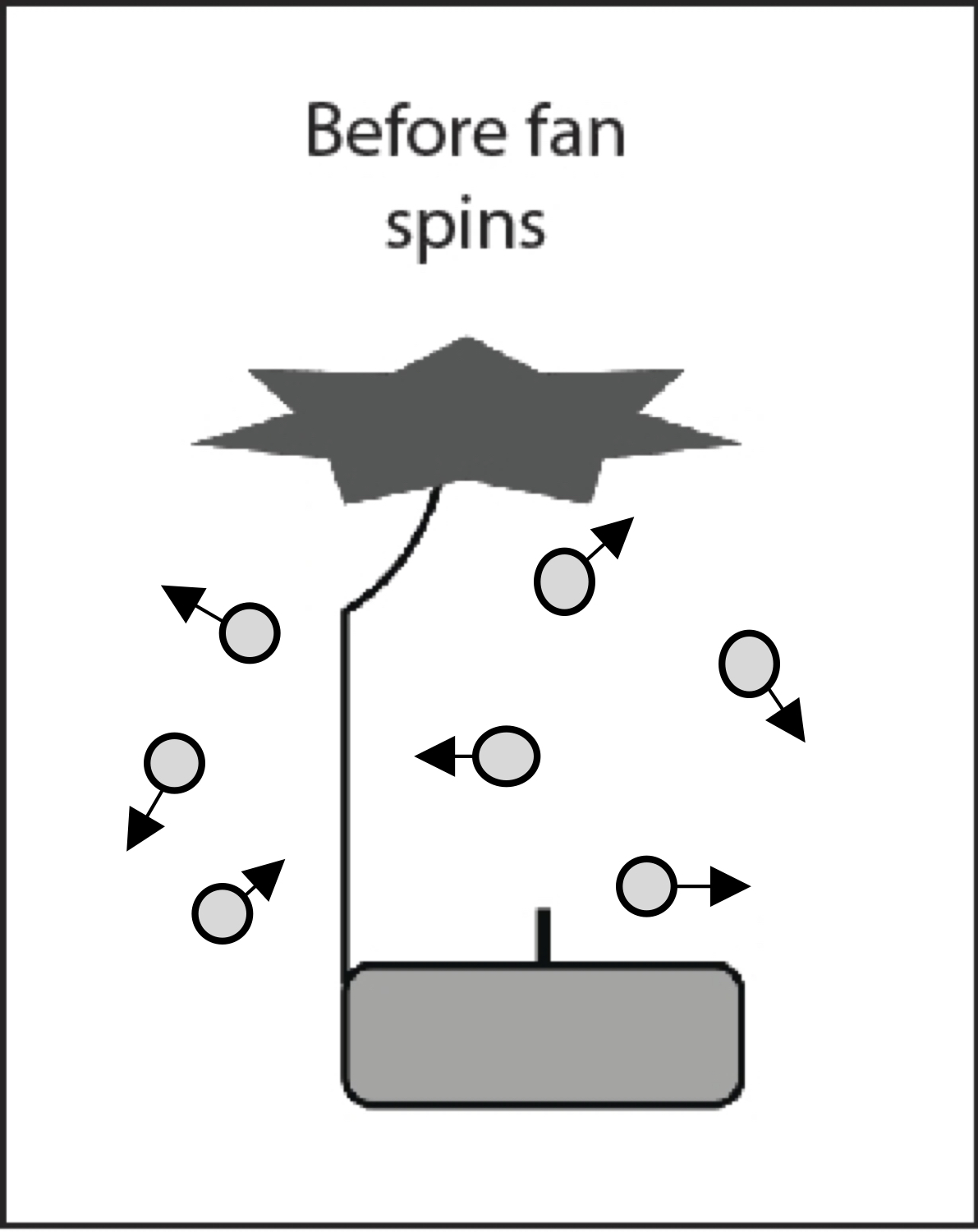Item AP017006: Develop a model to illustrate what causes a fan to spin when a candle is lit underneath it and defend a claim about cause-and-effect relationships that reflects knowledge about the atomic/molecular scale and ideas about energy transfer. (MC Version)
A teacher shows her class a demonstration of a fan that spins over a lit candle.

Watch the video to see the demonstration.
The students notice that the fan only spins after the candle is lit. They also notice that air around the fan and candle is warmer when the candle is burning than when the candle is not burning.
The teacher asks the students to use ideas about energy to describe what is happening when the fan is moving and when it is not moving. One student says that the increase in thermal energy of the air is causing the fan to spin. Another student disagrees and thinks that the increase in thermal energy is not enough to cause the fan to spin. She thinks that there must be a force involved.
1. The students decide to make a model to better communicate their ideas. The model below shows the candle/fan system before the candle is lit. The gray circles represent the molecules of air and the black arrows show the direction the molecules are moving. The length of the arrows represents the relative speeds of the molecules with longer arrows representing faster molecules. The model shows that before the candle is lit, the molecules of air are moving randomly around the candle and fan.

Create a model that represents the motion of the molecules of air and the energy transferred between the candle, air, and fan while the candle is lit and the fan is spinning. Your model should include:
- Gray circles to represent the molecules of air
- Black arrows to represent the speed and direction the molecules are moving
- Red arrows to represent the transfer of energy
2. Describe how the motion of the molecules of air changed from before the fan spins to while the fan is spinning.
3. Describe how energy is being transferred while the candle is lit and the fan is spinning.
4. Which of the following explains the roles that both the thermal energy of the air and forces play in causing the fan to spin?
A. Energy from the burning candle is transferred to the air around the candle, increasing the thermal energy of the air. The thermal energy moves upward and causes the fan to spin. Energy is a force and forces cause objects to move.
B. Energy from the burning candle is transferred to the air around the candle, increasing the thermal energy of the air. This means the air now contains more heat molecules. The heat molecules move upward to the fan and collide with the fan blades. The interaction between the heat molecules and the fan is a force that transfers energy to the fan causing it to spin.
C. Energy from the burning candle is transferred to the air around the candle, increasing the thermal energy of the air. This causes the molecules of the air above the flame to move faster. These faster moving molecules move upward and collides with the fan. This interaction between the air molecules and the fan is a force that transfers energy to the fan causing it to spin.
- Percent of Points Earned

- Points Earned
| Avg. Earned | Possible | Percent | |
|---|---|---|---|
| Q1 | 1.24 | 3 | 41% |
| Q2 | 0.53 | 3 | 18% |
| Q3 | 0.18 | 2 | 9% |
| Q4 | 0.3 | 1 | 30% |
- Overall Task Difficulty
| Total Points Earned | Total Points Possible | Total Percent | |
|---|---|---|---|
| 2.25 | 9 | 25% |
n = 193
Note: The total percent is a weighted average based on the total number of points earned divided by the total number of points possible.
- Science and Engineering Practices
- SEP2 Develop, revise, and/or use a model based on evidence to illustrate and/or predict the relationships between systems or between components of a system.
SEP7 Make and defend a claim based on evidence about the natural world or the effectiveness of a design solution that reflects scientific knowledge and student-generated evidence. - Crosscutting Concepts
- CC2 Cause and effect relationships can be suggested and predicted for complex natural and human designed systems by examining what is known about smaller scale mechanisms within the system.
CC5 The transfer of energy can be tracked as energy flows through a designed or natural system. - Disciplinary Core Ideas
- PS1.B Some chemical reactions release energy, others store energy.
PS3.A The term "heat" as used in everyday language refers both to thermal energy (the motion of atoms or molecules within a substance) and the transfer of that thermal energy from one object to another. In science, heat is used only for this second meaning; it refers to the energy transferred due to the temperature difference between two objects.
PS3.A At the macroscopic scale, energy manifests itself in multiple ways, such as in motion, sound, light, and thermal energy.
PS3.A These relationships are better understood at the microscopic scale, at which all of the different manifestations of energy can be modeled as a combination of energy associated with the motion of particles and energy associated with the configuration (relative position of the particles). In some cases the relative position energy can be thought of as stored in fields (which mediate interactions between particles). This last concept includes radiation, a phenomenon in which energy stored in fields moves across space.
PS3.C When two objects interact, each one exerts a force on the other that can cause energy to be transferred to or from the object.
PS4.B When light or longer wavelength electromagnetic radiation is absorbed in matter, it is generally converted into thermal energy (heat). Shorter wavelength electromagnetic radiation (ultraviolet, X-rays, gamma rays) can ionize atoms and cause damage to living cells.

